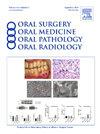孤立上颌中切牙综合征:SIX3基因的杂合致病变异
IF 1.9
3区 医学
Q2 DENTISTRY, ORAL SURGERY & MEDICINE
Oral Surgery Oral Medicine Oral Pathology Oral Radiology
Pub Date : 2025-07-21
DOI:10.1016/j.oooo.2025.04.038
引用次数: 0
摘要
孤立上颌中切牙(SMMCI)综合征,以前被称为“孤立上颌中切牙,身材矮小,后鼻孔闭锁/中鼻狭窄综合征”,是一种包括各种先天性中线缺陷的疾病。无前脑畸形是这种疾病最严重的表现之一,表现为显著的颅面和神经缺陷。产前可通过超声诊断;呼吸窘迫是婴儿后鼻孔闭锁/鼻中狭窄的主要症状。有些病人被诊断为单上颌初级中切牙的爆发。一些染色体异常与这种综合征有关,包括SHH基因的突变。病例发现:一名4岁男性,有单侧唇裂修复史,发育迟缓,鼻皮样囊肿。脑MRI未发现前脑无形性畸形。他的口腔内检查对初级牙列很重要,包括一个大的上颌中线初级中切牙,没有上颌唇系带。父母否认有创伤史。上颌咬合x光片显示一个单一的初级中切牙位于中线,以及一个单一的发展中的永久中切牙。其他所有牙齿似乎都发育正常。结果患者单侧唇裂、孤立上颌正中初级中切牙、鼻皮样囊肿、发育迟缓等表型符合SMMCI综合征。采用染色体微阵列(阴性研究)和Invitae无前脑畸形小组对患者进行了评估,该小组在SIX3基因中发现了一种杂合致病变异。SIX3基因在常染色体显性非综合征性前脑畸形中被观察到,并且SIX3与SMMCI综合征有关。结论smmci综合征是一种常染色体显性遗传的独特先天性异常。由于外显率降低,家族史可能呈阴性。单个对称的大上颌中切牙的呈现应该引起对先天性中线缺陷的关注,需要进行定向基因检测。本文章由计算机程序翻译,如有差异,请以英文原文为准。
Solitary median maxillary central incisor syndrome: heterozygous pathogenic variant in the SIX3 gene
Introduction
Solitary median maxillary central incisor (SMMCI) syndrome, previously referred to as “solitary median maxillary central incisor, short stature, choanal atresia/midnasal stenosis syndrome,” is a disorder that encompasses a variety of congenital midline defects. Holoprosencephaly is among the most serious presentations of this condition, manifesting in significant craniofacial and neural defects. The diagnosis can be identified with ultrasound prenatally; respiratory distress is the presenting symptom of choanal atresia/midnasal stenosis in infancy. Some patients are diagnosed upon eruption of the single maxillary primary central incisor. Several chromosomal abnormalities have been implicated with this syndrome, including mutations in the SHH gene.
Case Findings
A 4-year-old male presented with a history significant for repaired unilateral cleft lip, developmental delay, and a nasal dermoid cyst. Holoprosencephaly was not identified on brain MRI. His intraoral examination was significant for primary dentition including a single large maxillary midline primary central incisor, and no maxillary labial frenum. The parents deny history of trauma. A maxillary occlusal radiograph revealed a single primary central incisor located in the midline, as well as a single developing permanent central incisor. All other dentition appeared to be developing appropriately.
Results
The patient’s phenotype of unilateral cleft lip, solitary median maxillary primary central incisor, nasal dermoid cyst, and developmental delay are consistent with SMMCI syndrome. The patient was evaluated with chromosomal microarray (negative study) as well as Invitae Holoprosencephaly Panel which identified a heterozygous pathogenic variant in the SIX3 gene. SIX3 gene is observed in autosomal dominant nonsyndromic holoprosencephaly and SIX3 has been implicated in SMMCI syndrome.
Conclusion
SMMCI syndrome is composed of unique congenital abnormalities inherited in an autosomal dominant pattern. The family history may appear negative because of reduced penetrance. The presentation of a single symmetrical large maxillary central incisor should raise concern for congenital midline defects warranting directed genetic testing.
求助全文
通过发布文献求助,成功后即可免费获取论文全文。
去求助
来源期刊

Oral Surgery Oral Medicine Oral Pathology Oral Radiology
DENTISTRY, ORAL SURGERY & MEDICINE-
CiteScore
3.80
自引率
6.90%
发文量
1217
审稿时长
2-4 weeks
期刊介绍:
Oral Surgery, Oral Medicine, Oral Pathology and Oral Radiology is required reading for anyone in the fields of oral surgery, oral medicine, oral pathology, oral radiology or advanced general practice dentistry. It is the only major dental journal that provides a practical and complete overview of the medical and surgical techniques of dental practice in four areas. Topics covered include such current issues as dental implants, treatment of HIV-infected patients, and evaluation and treatment of TMJ disorders. The official publication for nine societies, the Journal is recommended for initial purchase in the Brandon Hill study, Selected List of Books and Journals for the Small Medical Library.
 求助内容:
求助内容: 应助结果提醒方式:
应助结果提醒方式:


